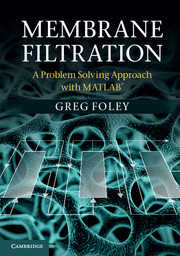Book contents
- Frontmatter
- Dedication
- Contents
- Preface
- Abbreviations
- 1 Introduction to membrane filtration of liquids
- 2 Dead-end filtration
- 3 Crossflow microfiltration
- 4 Ultrafiltration flux theories
- 5 Ultrafiltration process analysis and design at the limiting flux
- 6 Diafiltration at the limiting flux
- 7 Ultrafiltration and diafiltration with incomplete rejection
- 8 The osmotic pressure model applied to ultrafiltration and diafiltration
- 9 Reverse osmosis and nanofiltration
- 10 Membrane fouling
- Appendix Mathematical and computational background
- Index
- References
6 - Diafiltration at the limiting flux
Published online by Cambridge University Press: 05 July 2013
- Frontmatter
- Dedication
- Contents
- Preface
- Abbreviations
- 1 Introduction to membrane filtration of liquids
- 2 Dead-end filtration
- 3 Crossflow microfiltration
- 4 Ultrafiltration flux theories
- 5 Ultrafiltration process analysis and design at the limiting flux
- 6 Diafiltration at the limiting flux
- 7 Ultrafiltration and diafiltration with incomplete rejection
- 8 The osmotic pressure model applied to ultrafiltration and diafiltration
- 9 Reverse osmosis and nanofiltration
- 10 Membrane fouling
- Appendix Mathematical and computational background
- Index
- References
Summary
Introduction
Diafiltration (DF) is the removal of low molecular weight solutes, such as salts, from a solution of a high molecular weight solute, such as a protein. The basis of the separation is that the high molecular weight solute (‘macrosolute’), or particle, does not pass through the membrane but the low molecular weight ‘microsolute’ does. It is somewhat similar to dialysis but, in the latter, a dialysing fluid flows counter-currently on the permeate side, providing a mass transfer driving force that enhances removal of the microsolute. Dialysis is discussed briefly towards the end of this chapter.
There are many ways to perform DF and in this chapter a number of different approaches are examined. Throughout the analyses presented, the solution is assumed to be composed of two solutes; a macrosolute whose concentration is denoted by cA and a microsolute whose concentration is denoted by cB. Complete rejection of the macrosolute is assumed throughout and the microsolute is assumed to have a rejection coefficient of zero. An additional and important assumption is that the flux is determined by the macrosolute concentration only. Furthermore, the flux is assumed to be at the limiting value as given by the limiting flux model. The one exception to this is in Section 6.4.3, where a more complex, essentially empirical, model for the flux is used. The most notable feature of that model is that the flux depends on the concentrations of both the macrosolute and the microsolute.
- Type
- Chapter
- Information
- Membrane FiltrationA Problem Solving Approach with MATLAB, pp. 152 - 193Publisher: Cambridge University PressPrint publication year: 2013



